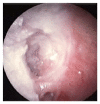Clinical Challenges in the Diagnosis and Treatment of Temporal Bone Osteomyelitis
- PMID: 28487802
- PMCID: PMC5401737
- DOI: 10.1155/2017/4097973
Clinical Challenges in the Diagnosis and Treatment of Temporal Bone Osteomyelitis
Abstract
Temporal bone osteomyelitis is a serious life-threatening condition-a quick and proper diagnosis is needed to start treatment and reduce morbidity and mortality. Changing trends of the disease make a differential diagnosis difficult. To emphasize the importance of a clinical suspicion of this dangerous condition, our experience with three difficult cases is presented. The diagnosis was based on clinical symptoms, otoscopic findings, and findings on computed tomography or magnetic resonance imaging. Neoplasm and granulomatous inflammation were excluded by multiple biopsies. The disease can develop in nondiabetic patients. The disorder might be related to the initial inflammatory process in the middle ear with further direct spreading of infection through defects in the bony walls to deep temporal bone structures. Imaging should be performed early to detect osteolytic lesions of the skull base. Surgery was used for the presence of bone sequestra and infratemporal abscess.
Figures







Similar articles
-
More advantages in detecting bone and soft tissue metastases from prostate cancer using 18F-PSMA PET/CT.Hell J Nucl Med. 2019 Jan-Apr;22(1):6-9. doi: 10.1967/s002449910952. Epub 2019 Mar 7. Hell J Nucl Med. 2019. PMID: 30843003
-
A Case of Infratemporal Fossa Abscess with Signs of Chronic Maxillary Osteomyelitis.Bull Tokyo Dent Coll. 2015;56(2):121-9. doi: 10.2209/tdcpublication.56.121. Bull Tokyo Dent Coll. 2015. PMID: 26085000
-
[The place of computed tomography and magnetic resonance tomography in the diagnosis of bone sequestra].Aktuelle Radiol. 1992 Nov;2(6):345-9. Aktuelle Radiol. 1992. PMID: 1457476 German.
-
Cryptococcal skull infection: a case report with review of the literature.Neurosurgery. 1993 Jun;32(6):1034-6; discussion 1036. doi: 10.1227/00006123-199306000-00028. Neurosurgery. 1993. PMID: 8327080 Review.
-
[Chronic infections of the skeletal system. Their imaging diagnosis].Radiologe. 2000 Jun;40(6):547-56. doi: 10.1007/s001170050752. Radiologe. 2000. PMID: 10929391 Review. German.
Cited by
-
Malignant otitis externa with subsequent internal jugular vein thrombosis and hypoglossal palsy: a report and review of literature.J Otol. 2020 Sep;15(3):112-116. doi: 10.1016/j.joto.2020.01.004. Epub 2020 Jan 25. J Otol. 2020. PMID: 32884563 Free PMC article.
References
-
- Slattery W. H., III, Brackmann D. E. Skull base osteomyelitis: malignant external otitis. Otolaryngologic Clinics of North America. 1996;29(5):795–806. - PubMed
Publication types
LinkOut - more resources
Full Text Sources
Other Literature Sources

